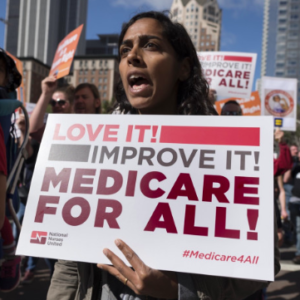Among Democrats, the “public option” may be rising in discussions as a less radical approach to health insurance than “Medicare for All” (M4A). Yet history suggests caution over this seemingly more pragmatic approach.
Senator Bernie Sanders offered an M4A bill to establish a single-payer health insurance system. The federal government would finance health care through taxation and provide all Americans with coverage. Today’s employer-based insurance, individual policies, Medicaid and Medicare would vanish, replaced by government-run insurance.
Many left-of-center lawmakers are reluctant about M4A. My colleague Charles Blahous estimated that federal government spending would rise by at least $32.6 trillion over ten years — that being a rock-bottom estimate. Doubling all individual and corporate income tax collections wouldn’t fully cover that amount. Income- or wage-based taxation would depress the overall economy, compared with the current system of financing health insurance. (I explained this in “Medicare for All: Taxes and Tradeoffs.”)
Vermont, California and Colorado recently considered state-level single-payer systems, but financing issues stopped those efforts.
Enter the public option. Details differ from plan to plan. The idea is that governments (federal, state or local) would establish publicly-owned health insurance companies to compete with existing insurers. If private insurers don’t satisfy consumers in terms of cost or quality, those consumers could turn to the government’s insurance arm for coverage. That’s the argument.
Generally, consumers would pay premiums as they do in private markets, so the public option seemingly avoids economy-depressing characteristics of a single-payer system. If governments explicitly or implicitly subsidize the public option, you get a bit of that economy-depressing problem, but not as much as with M4A.
Public option supporters argue that a government-provided alternative insurance plan would push costs down. For example, Representative Brad Schnieder (D-Ill.) said, “A new public plan would promote competition to drive down overall costs and return the focus more appropriately on patients and their needs.” The trouble is, this idea has been tried in a variety of ways, and the impacts have ranged from negligible to disastrous.
In May 2019, Washington state created a public option whose policies won’t be available until 2021. The governor’s office estimates the public plan’s premiums would be 5 to 10 percent lower than competing plans. Ostensibly, savings would come from restricting the incomes of health care providers. Politico notes, however, that the legislation includes multiple ways that providers can escape the spending cuts. This echoes the federal government’s Sustainable Growth Rate, which promised Medicare spending cuts for nearly two decades and which failed to do so year after year.
Los Angeles has had a public option for some years — the subject of a recent Atlantic article. Summing up the article, “The plan has created a sturdy competitor to private insurers, but it hasn’t had a transformative effect on cost.”
The public option isn’t a new idea, however. The 1990s and early 2000s were littered with attempts to expand coverage and lower costs by putting states into the health insurance business. The results were varied and bad. Here are just some:
In 1994, Tennessee used its TennCare Medicaid program to expand coverage to the uninsured. People lost existing coverage and were forced into the program. Providers fled. The state treasury hemorrhaged. Ultimately, the state dropped 200,000 residents from their newly acquired coverage.
In 1994, Kentucky enacted a law strongly resembling major features the Affordable Care Act, but with a public option — Kentucky Kare — for those in the individual market. Dozens of private insurance left the state, with only Blue Cross and Kentucky Kare remaining. The plan bled the state treasury, and the reforms were eventually scrapped.
In 2003, Maine spent a fortune establishing DirigoChoice. Hardly anyone signed up.
In 2009, Hawaii created Keiki Care to provide state-financed coverage to uninsured children. Loads of people stopped buying their children private insurance and went onto Keiki Kare. Within seven months, the program was out of money and dismantled.
Like the Affordable Care Act, Republican repeal-and-replace proposals, and M4A, the public option assumes that we can cut costs and expand coverage by altering the payment system. All of these ideas neglect the supply side — the quantity and quality of resources available for health care and how we deliver that care.

